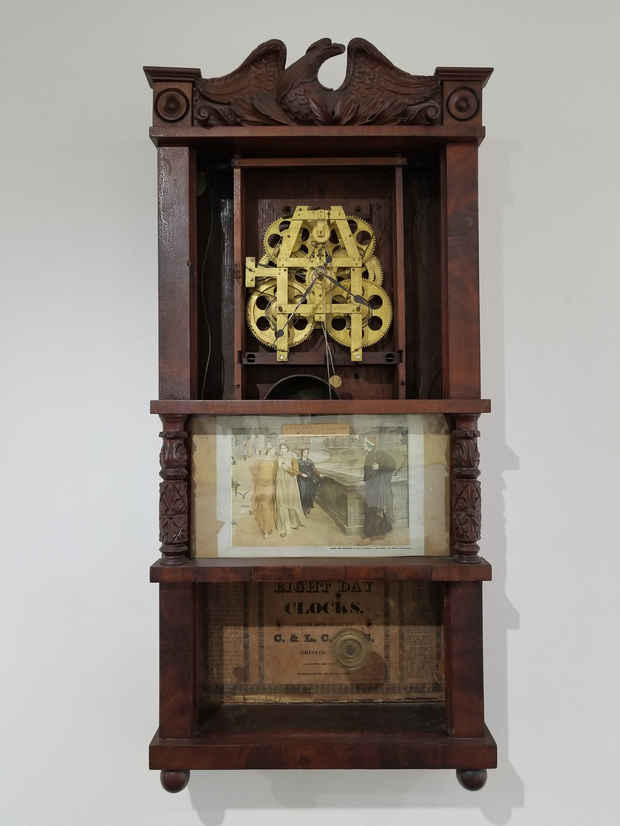“Reset” Exhibition
Kai Matsumiya

This event has ended.
What kinds of art would survive in the event of an environmental apocalypse? What new kinds of art would emerge? How would our very definition of “art” change if the figurative reset button were pressed on the world as we know it? Our current group exhibition, “Reset,” explores these questions, imagining the gallery as a post-apocalyptic, dystopian laboratory in which ostensibly permanent laws of nature, technology, and culture can be reconfigured.
The spirit of machines has been indispensable in rendering, modifying, and even destroying societal norms and laws, and art is certainly not immune to its consequences. The historical avant-garde was inextricable from the technological and industrial developments that defined their world, with the early French modernists referring to their own works as ‘machines’ suggesting both mechanistic dynamism and un-utilitarian creativity. The useless machine is essentially a reset button— built solely to turn itself off upon being turned on, thereby setting the process anew.
The late Marvin Minsky, once a researcher at Bell Labs Inc., devoted his career to two principal pursuits: making strides in the development of artificial intelligence and building “the most profoundly useless things” he could think of. These two projects may seem incongruous, but for Minsky they became intimately intertwined through one of his best-known inventions, the “useless machine.” For Minsky, the most advanced artificial intelligence would be capable of the most intimate, intelligent, private, and quintessentially human act, suicide. Thus, a machine that truly possessed the capacity for human intelligence would be a useless one: one whose only function is to switch itself off. Claude Shannon, a pioneer of information theory and cybernetics, was delighted by the concept of a useless machine and placed an assortment of them on his desk to entertain those who visited his office. But not everyone found the useless machine quite so amusing— Arthur C. Clarke, upon encountering an early prototype, called the device “unspeakably sinister.”
Clarke cannot be faulted for seeing something sinister in the useless machine’s built-in death drive, but a reset button leaves room for hope even in the most sinister of times: pressing reset opens up the possibility of starting all over again. The machines-as-art displayed in “Reset” carry with them a similar sense of possibility, shedding light on the laws that have traditionally governed the gallery and the ways that, once the reset button has been pressed, both the artist’s and the gallery’s relationship to these laws are subject to change.
Kai Matsumiya gives special thanks to Keenan Jay, Eva Silverman, Drew Healy, Liz Koury, and all of the artists in the show (Joan Jonas, Craig Kalpakjian, Andrew Ross, Victoria Haynes, Micaela Carolan, Joseph Kosuth (fake), Carol Szynmanski, Ben Morgan Cleveland, Steffani Jemison, Rainer Ganahl, Ala Dehghan, Jason Hirata, Ficus Interfaith, Amy O’Neil, Elliott Jamal Robbins, Cassidy Toner, Maggie Lee, Racque Ford, Peter Fend, Jason Matthew Lee, Pedro Wirz, Greg Fadell).
Media
Schedule
from February 06, 2019 to March 10, 2019
Opening Reception on 2019-02-06 from 18:30 to 21:00
Artist(s)
Joan Jonas, Craig Kalpakjian, Andrew Ross, Victoria Haynes, Micaela Carolan, Peter Fend, Joseph Kosuth (fake), Carol Szymanski, Ben Morgan Cleveland, Ala Dehghan, Steffani Jemison, Rainer Ganahl, Jason Hirata, Ficus Interfaith, Amy O’Neill, Elliott Jamal Robbins, Cassidy Toner, Maggie Lee, Raque Ford, Jason Matthew Lee, Pedro Wirz, Greg Fadell